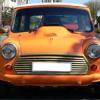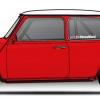So the bottom line is and I researched this extensively prior to rebuilding my car, (rang VOSA and spoke to a really helpful guy) replacement of structural monocoque car panels have to be spot welded or seam welded in place. None monocoque panels which on a mini are the A panels, front wings and front panel are not included so can be fixed however you want, although he said welding is best from a safety point of view.

Body Panel (Welding Versus Riveting)
Started by
mikey8384
, Aug 07 2012 04:06 PM
20 replies to this topic
#16

Posted 08 August 2012 - 10:24 AM
#17

Posted 08 August 2012 - 10:51 AM
if you fix your front on your mini like that i would also fit flip front brace bars
problem is VOSA don't understand how a mini is put together, it's the wings and front panel that hold the front subframe on
problem is VOSA don't understand how a mini is put together, it's the wings and front panel that hold the front subframe on
#18

Posted 08 August 2012 - 12:03 PM
I have to agree with you bungle.
If your going to fit a front end in any way other than factory spec, you will need to use brace bars to support the front of the subframe.
This is essential to the crash structure at the front of the shell. If you don't reinforce the area with the brace bars, or weld along the inner wings and A-panel joins you risk ending up with the front subframe puncturing the cabin and taking off your legs.
The same would apply with the floor panels, unless it's welded tight you risk even a small amount of play in a riveted joint (even joint mastic flexes after drying!). This play will eventually shear the rivets and allow the stressed structure to collapse and fall apart with the occupants inside.
I fell through the floor of my old mini after going over a humpback bridge and discovered that the floor repair was only tacked in place and then seam sealed over. This was the point that I learnt to weld and haven't gone back to that garage again!
If your going to fit a front end in any way other than factory spec, you will need to use brace bars to support the front of the subframe.
This is essential to the crash structure at the front of the shell. If you don't reinforce the area with the brace bars, or weld along the inner wings and A-panel joins you risk ending up with the front subframe puncturing the cabin and taking off your legs.
The same would apply with the floor panels, unless it's welded tight you risk even a small amount of play in a riveted joint (even joint mastic flexes after drying!). This play will eventually shear the rivets and allow the stressed structure to collapse and fall apart with the occupants inside.
I fell through the floor of my old mini after going over a humpback bridge and discovered that the floor repair was only tacked in place and then seam sealed over. This was the point that I learnt to weld and haven't gone back to that garage again!
#19

Posted 08 August 2012 - 12:45 PM
I agree with Bungle, the front panel, inner and outer wings and A panels are very clearly stressed parts of the monocoque. Indeed, if you have a rubber mounted subframe, they are often found to be inadequate, as the inner wings start to crack vertically just forward of the subframe towers. Sometimes, but not always, it is due to failed toeboard mounts. If it suffers structural cracking, it is stressed.
In any case the MOT rule about distance from suspension or subframe mounts, set by none other than VOSA, applies to every single one of these panels.
This is at least the second time on this forum that someone from VOSA, clearly with no structural knowledge, has talked complete nonsense.
In any case the MOT rule about distance from suspension or subframe mounts, set by none other than VOSA, applies to every single one of these panels.
This is at least the second time on this forum that someone from VOSA, clearly with no structural knowledge, has talked complete nonsense.
#20

Posted 08 August 2012 - 06:03 PM
Going back to planes v cars, I was once party to a conversation between a couple of friends on almost identical lines to the question asked. My planey friend worked for KLM at the time and was arguing for rivet construction. The argument went on for several pints until my other mate summed it up perfectly, 'cars are designed to crash, planes aren't. Apart from the above comments about MOT etc I personally wouldn't go in a car with riveted oversills and wouldn't suggest anyone else did either.
#21

Posted 08 August 2012 - 07:08 PM
Well thank you all for the inputs given, I think from a general consensus that I will be learning how to weld and do it the right way.
1 user(s) are reading this topic
0 members, 1 guests, 0 anonymous users
















